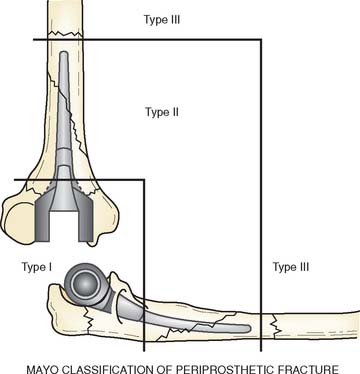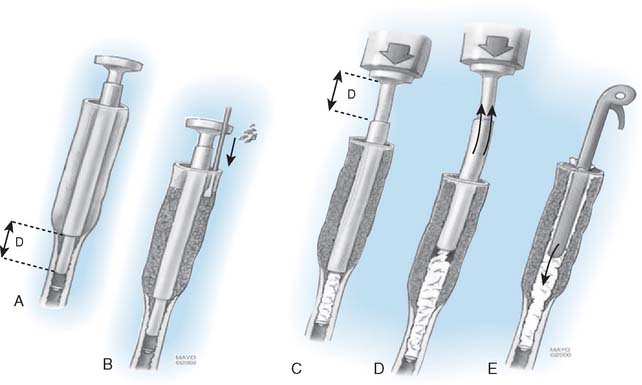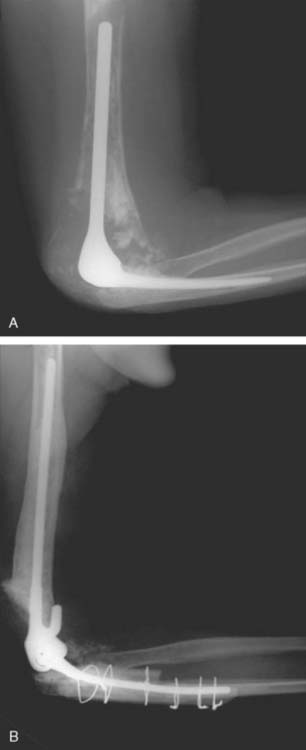CHAPTER 66 Revision of Failed Total Elbow Arthroplasty with Osseous Deficiency
INTRODUCTION
There are several expressions of osseous deficiency. These include (1) deficient length, resulting from absent distal humerus or proximal ulna; (2) compromised bone quality secondary to osteolysis characterized by ballooning of an intact cortex; and (3) periprosthetic fracture. We have classified the periprosthetic fracture as proximal (I) (metaphyseal), with stem involvement (II), or past the stem (III) (Fig. 66-1). From a revision standpoint, the type II fracture involving the stem or a type III fracture proximal or distal to the tip of the stem are of greatest significance. Because the rationale and technique of revision have been covered in detail in Chapter 65, herein we describe three techniques that are used for reimplanation revision following failed total elbow arthroplasty in the face of osseous deficiency. These techniques include impaction grafting, allograft strut grafting, and allograft prosthetic composite. Obviously, impaction grafting and strut grafting can be used in conjunction with these other techniques as well. Implant selection is an important issue. Some have employed unlinked devices in some cases of revision with osseous compromise.4 Others have employed custom designs for such problems.5 We believe that these problems require a linked implant with multiple sizing options.
IMPACTION GRAFTING
SURGICAL TECHNIQUE
Bone preparation follows the same basic steps:
Note: The radial nerve is vulnerable in those with osteolysis extending to the spiral groove and may be injured when removing the membrane.14
RESULTS
The value of impaction grafting was described originally for acetabular deficiencies by Schreurs et al.13 A 20-year experience with impaction grafting and cemented acetabular component revealed excellent long-term results as well as biopsy evidence of viability and incorporation of the impacted graft. This provides a rationale and a basis for the application at the elbow. We have recently reviewed our experience with 12 patients undergoing revision elbow arthroplasty using an impaction grafting technique between the years 1993 and 1997.9 The average surveillance period was 6 years, with a minimum 2-year follow-up. Recognizing that this represents a salvage-type revision, at the time of last follow-up, eight were intact after the index procedure (Fig. 66-3). In addition, two other patients underwent revision because of loosening and a third required revision due to a subsequent failure of the unrevised ulnar component. One patient developed an infection. Of the eight remaining patients, marked radiographic improvement was observed. At the final follow-up after the additional revision in three patients, five were excellent and four were good with three fair results. This suggests that impaction grafting is a viable option as a salvage for the difficult revision with poor bone quality due to osteolysis.












